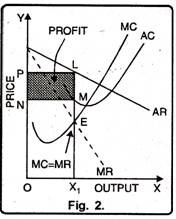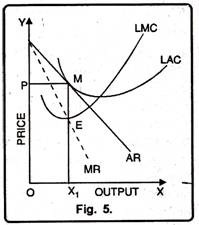According to Prof. Chamberlin, the firm under monopolistic competition has to make a wider range of decisions than under perfect competition. The firm may vary its price and with it, its sales and output; it may vary the quality of its product and it may engage in sales-promotion activities such as advertisement, publicity and propaganda, etc.
Thus, there are three variables under monopolistic competition, viz.;
(i) Price,
(ii) Product; and
(iii) Selling outlay.
It would be very difficult to discuss their effects simultaneously. Therefore, the equilibrium of individual firm is discussed here with reference to prices and output adjustments, assuming that the selling costs are absent. In other words, now we shall examine the individual equilibrium and then examine group equilibrium.
Individual Equilibrium:
It should be recalled here that for maximum profits two conditions are to be satisfied under perfect competition and monopoly; (1) MC = MR and (2) MC must cut MR from below. Under monopolistic competition also, a firm will make the maximum profits when these two conditions are satisfied.
However, in short period, it is not necessary that all the firms should have iso-classic demand curves. The elasticity of demand curve under monopolistic competition depends upon the attachment of the buyers. So, this it will depend upon the age of the firm (and of the product).
ADVERTISEMENTS:
If a firm is an old one, it shall be selling its product for a long time and consequently the buyers will have a less elastic or inelastic demand for its products. On the contrary, a comparatively, new firm will have a more elastic demand curve for its product.
Thus, older firms will have greater price advantage while newer firms will have lesser price advantage. Since it is assumed that product differentiation or the effects of selling costs are absent, cost curves of different firms will be identical.
It follows therefore that older firms will make abnormal profits while newer firms may have normal profits or even losses. To be very clear and simple, it is stated that there may be three equilibrium conditions of a firm in the short period under monopolistic competition, viz.
(1) It may earn abnormal profits;
ADVERTISEMENTS:
(2) It may undergo losses;
(3) It may earn only normal profits.
(4) Super Normal Profit
Under monopolistic competition, a firm earns maximum profits or is in equilibrium when MC=MR and MC cuts MR from below. In the fig. 2. the firm is in equilibrium at OX] level of output and at the point E, at which MR and MC are equal and MC cuts MR from below.
ADVERTISEMENTS:
The firm is earning super-normal profits or abnormal profits since average revenue is greater than average cost, i.e., AR > AC. The main reason for these abnormal profits is that, the other rival firms are not able to produce closely competitive substitutes. Hence, they are not able to attract consumers towards their product.
2. Normal Profit:
If under monopolistic competition, the price of product is equal to AC, the firm will be earning normal profit. In Fig. 3 MC is equal to MR at point E. This is the equilibrium point. At equilibrium point, the equilibrium output is OX1 and price is OP1. At this point, AC is NX1 and AR is also NX1 i.e., AC=AR. Thus the firm will be earning only normal profits.
3. Sustaining Losses:
ADVERTISEMENTS:
However, it is also possible that the demand may not be favourable to firm under monopolistic competition, i.e., it may not be able to attract the consumers towards its product, if it fixes price equal to its SAC. But it is compelled to sell its product at the price which is less than even its short period average cost.
Hence, it may incur losses such firm, in the long-run may leave the industry, if it is not possible for it to change its demand relative to its cost conditions through product differentiation and advertisement. In figure 4 the firm is in equilibrium at point E, where MC=MR. At this equilibrium level the output is OX1 at price OP. Corresponding to this, the average cost LX1 is greater than average revenue MX1, Since, revenue is less than cost, the firm will sustain losses equal to the shaded area PLMN.
Long Run Individual Equilibrium:
Long period refers to that time period in which each firm can change its production capacity by changing the fixed as well as variable factors. New firms can enter the industry and old firms can exit it. Basically, the firms in the long run will get the normal profits.
If, the existing firms are making super normal profits, it will attract some of the new firms in the industry. The entry of new firms will result into over production which will have a depressing effect on price. Hence all the firms in the long run will get normal profits. In fig. 5 output is measured on X-axis whereas price on Y-axis. LAC is the long run average cost and LMC is the long fun marginal cost curve. The firm is in equilibrium because at point E, MC = MR. The equilibrium output is OX1 and price is OP. Since, at this equilibrium average revenue curve is tangent to long run average cost curve at point M; hence the firms are earning normal profits.



